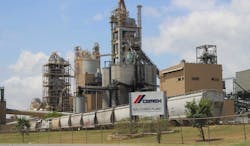Cemex USA and RTI Research to study Carbon Capture at Texas Cement plant
Building materials maker Cemex USA has been awarded a $3.7 million cooperative agreement from the U.S. Department of Energy to conduct a front-end engineering design (FEED) study on integrating a carbon capture system at its cement manufacturing plant in New Braunfels, Texas in collaboration with non-profit research institute RTI International and global technology firm SLB.
The agreement is part of Cemex’s Future in Action program aimed at reducing carbon emissions throughout the value chain of the building materials firm.
The study will include the use of RTI's non-aqueous amine technology and determine and evaluate the costs of integrating a 670,000 tonne-CO2 per year commercial-scale carbon capture system into the manufacturing process.
The 18-month study will include the evaluation of carbon capture from cement flue gas redirected into a tower to react with RTI's non-aqueous solvent (NAS) capture technology with a 95% CO2 capture efficiency. The NAS to be utilized in this project has been developed over the last ten years in several DOE-funded projects.
Read EnergyTech's full coverage of Carbon Capture projects in the C&I Energy Transition
Subscribe to our free, tri-weekly Email Newsletter for more on Decarbonization
"CEMEX has ambitious CO2 reduction goals, and we remain committed to exploring technologies that can help us meet our targets as we build a more sustainable future," said CEMEX USA President Jaime Muguiro. "We are striving to cut emissions across all our operations, and this study with RTI is one of the many steps CEMEX is taking to achieve our objectives."
NAS reportedly lowers the parasitic energy penalty for CO2 capture 30-40% compared to earlier solvent technologies and has been demonstrated successfully through the engineering scale, RTI’s principal project investigator Vijay Gupta said.
"RTI is pleased to work with CEMEX on the FEED study to demonstrate the benefits of the NAS technology at its cement manufacturing plant in Texas."
This is the second grant-backed initiative at the CEMEX Balcones plant since 2020. It is expected to cost $4.6 million overall.
Another carbon capture study concluded recently at the same plant examined the use of membrane technology.
Meanwhile, CEMEX and RTI are also conducting a Carbon Capture, Utilization and Storage study at the Victorville cement plant in California that examines the costs for implementing a NAS carbon capture system with a modular design.
About the Author
EnergyTech Staff
Rod Walton is senior editor for EnergyTech.com. He has spent 17 years covering the energy industry as a newspaper and trade journalist.
Walton formerly was energy writer and business editor at the Tulsa World. Later, he spent six years covering the electricity power sector for Pennwell and Clarion Events. He joined Endeavor and EnergyTech in November 2021.
He can be reached at [email protected].
EnergyTech is focused on the mission critical and large-scale energy users and their sustainability and resiliency goals. These include the commercial and industrial sectors, as well as the military, universities, data centers and microgrids.
Many large-scale energy users such as Fortune 500 companies, and mission-critical users such as military bases, universities, healthcare facilities, public safety and data centers, shifting their energy priorities to reach net-zero carbon goals within the coming decades. These include plans for renewable energy power purchase agreements, but also on-site resiliency projects such as microgrids, combined heat and power, rooftop solar, energy storage, digitalization and building efficiency upgrades.
